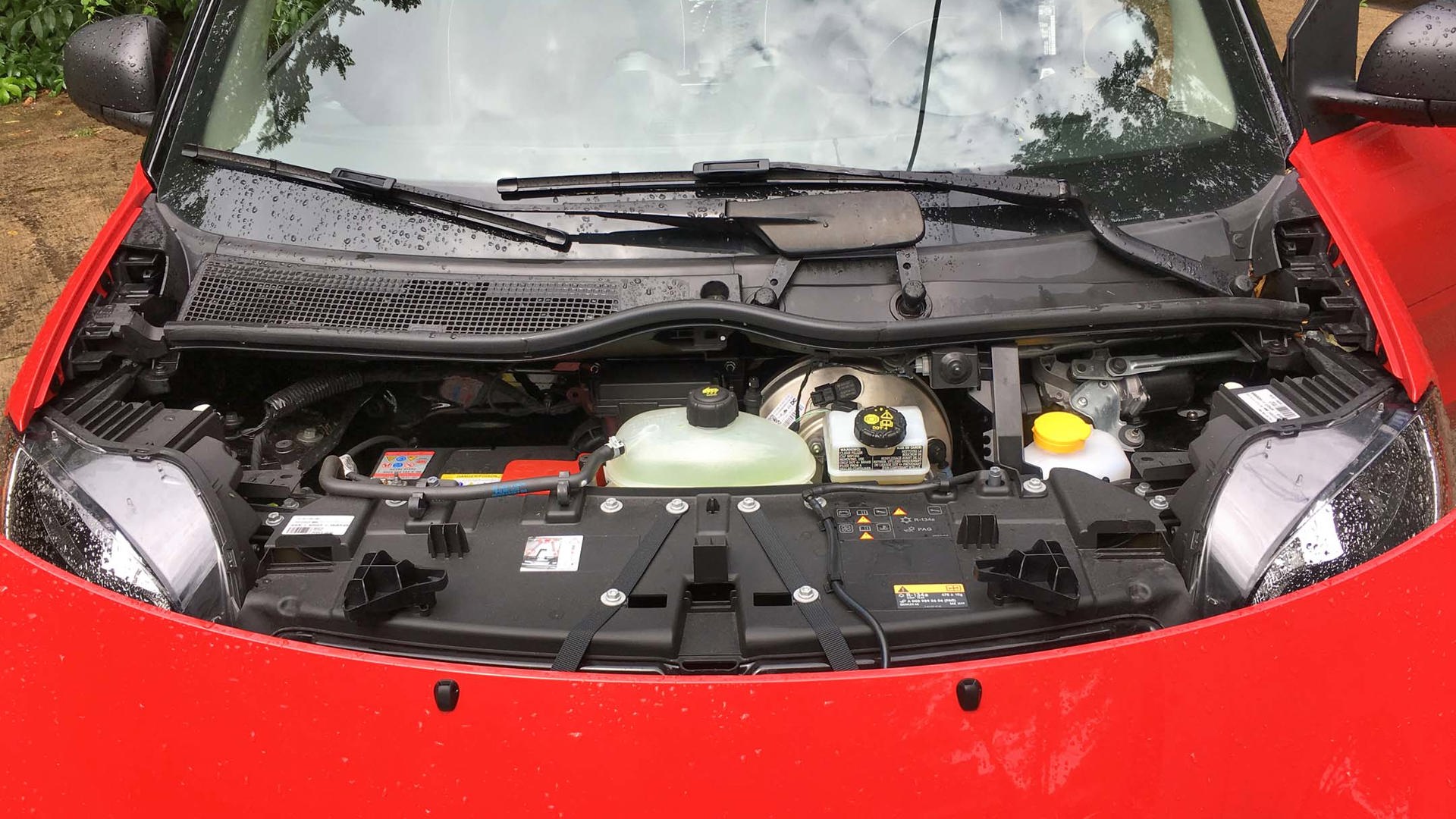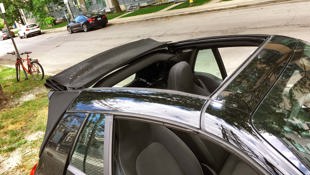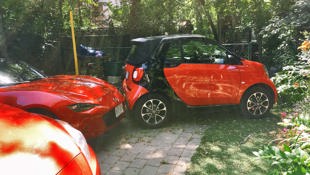 AutoTrader SCORE
AutoTrader SCORE
-
STYLING8/10
-
Safety7/10
-
PRACTICALITY8/10
-
USER-FRIENDLINESS8/10
-
FEATURES7/10
-
POWER6/10
-
COMFORT7/10
-
DRIVING FEEL7/10
-
FUEL ECONOMY9/10
-
VALUE8/10
With reluctant field research and content input by Orson Bochenek
From the beginning, Smart cars were pitched as the perfect vehicle for the urban animal. This February, Daimler announced that as of next year new North American Smart cars would all be electric. Their decision makes sense: gasoline smoke is clogging city dwellers’ lungs and noses worse than a flatulent retriever who raided last Thanksgiving’s turkey drippings. The fact that electric Smarts are a superior ride and more expensive than gasoline-powered models are just gravy, so to speak. Daimler’s decision explains why a quick internet search shows fire-sale prices – speaking of smoke – on gas-powered Smart cars like the Fortwo Cabrio Passion.
Can the tiny 2017 Smart Fortwo Cabriolet transport 36 kg (80 lb) of living canine flesh across the city to the beach on hot summer days? And, if so, is it easy?
Hence, the photo of our pet Labrador Orson, an urban animal, pointing out the Smart Car’s imminently obsolete gas cap door. At least that’s part of the reason.
Initially this story was pitched as a sort of mashup of this publication’s helpful Big Guy, Small Car series and Marley and Me. What ensued was more like a tragicomic episode of the late Stuart McLean’s Vinyl Café. Things didn’t go according to plan – except maybe for the mashup part.
The big question: can the tiny 2017 Smart Fortwo Cabriolet transport 36 kg (80 lb) of living canine flesh across the city to the beach on hot summer days? And, if so, is it easy?
In case you’re in a hurry, the short answers are yes and no. However, the second demands some context. Just because Orson didn’t say no to this experiment, that didn’t mean yes.
The Smart trunk is a 350L solution for transporting your dog
Unlike small sedans and roadsters, a Smart car has an open trunk, like an SUV’s. Technically, you could transport a biggish dog back there. Cover the area with a favourite blanket and you can minimize the effects of shedding. (I’ve vacuumed our dog’s hair from vehicles he’s never been in.)
To let the sun in, press two separate buttons, then two separate sections of the Cabrio’s cloth roof can fold neatly like hand fans. Overhead it collapses backwards like a horizontal Venetian blind. The back section also houses the rear window; the button unlatches this unit from the gate for it to roll a half-arm’s length up and inwards. The gate itself swings down 90 degrees to create a “table” about 2.5 feet (730 mm) up before the open trunk.
Together, the sitting table and retracted window form a gaping maw. Inside there’s nearly 350 litres of packing space. Though narrow, it should be enough to contain Orson.
“Up!” I indicate the open trunk.
Most dogs understand pointing commands. Some obey them. Typically a laconic companion, Orson can express surprisingly articulate thoughts wordlessly. His inaction yells, “I don’t want to go in the trunk.”
Maybe he just needs some encouragement, I think. It’s only 2.5 feet. My cargo shorts are stuffed with kibble for bribing. For this story, I actually measured his hindquarters: 50 cm (19.7") high and 16 cm (6.3") thick at their widest. It’s an easy jump.
Though Labradors are effectively furry garbage trucks, even they can’t be bribed all the time. He’s strong but refuses to use those muscular legs to leap to the open trunk – not even for treats.
So I lift him. He resists. It hurts. His hind hocks are 16 cm thick and culminate in tough claws. Note the photo of the inner section of the gate. This tabletop is also a plastic lid, sealed with bungee straps, which opens upwards to reveal fitted housing for the removable roof bars above the doors. However, I don’t dare even retract the roof lest Orson leap out to chase a bird, squirrel, cat or any other urban animals.
Note the other photo. I will only unroll the window enough to allow airflow.
Anyway, to recap: the table’s lid is plastic, Orson’s legs are strong and his untrimmed hind claws could effortlessly mar it. Moreover there are icons molded onto this plastic tabletop, indicating the limits of its utility: a maximum of 100 kg (220 lb) is easily more than enough to support even a strong 80 lb Labrador but there’s the added pressure of a good kick. Most relevant, there’s a deductible that reviewers sign when borrowing testers from Mercedes-Benz Canada, the providers of Smart cars.
So let’s not push our luck, Orson laconically suggests with a hurt look. We agree that he won’t ride in the trunk. He does however condescend to the passenger’s seat once it’s covered with a favourite blanket and festooned with kibble.
“Stay!”
Amazingly he stays without extra coercion. Not long ago, he’d have launched himself out of any vehicle we’d stuff him in before we could shut the door. This mere sitting – “Stay!” – constitutes progress. So here we are: packed at last and ready to drive to the beach. Progress, indeed.
A quick word on parking the Smart Fortwo as we drive away
Mirrors folded, the Smart is just 1,747 mm wide; nose to nether regions, it’s just 2,695 mm long; and 1,553mm tall. Wow: if it weren’t for the aerodynamic triangle sliced out of its profile, you’d almost have a rolling cube. Which makes it easy to park.
During part of the week it was my loaner, autoTRADER.ca also had me stowing a Mazda MX-5 (#FirstWorldProblemsAreReal); all the while visitors used our second parking spot.
Note the photos. The Smart slanted off our parking pad, almost crushing our flowers, but leaving enough room for the Mazda roadster and to shut the gate (eliminating Orson’s escape route for chasing other urban animals).
I think to myself as we proceed down our lane to the street, you could not have performed such parking with any other cars in the market.
Toronto’s Cherry Beach and nearby Port Lands have a checkered past.
Not four kilometres from the CN Tower, the immense (356 hectares) Port Lands have mostly been abandoned for decades. Such would-be priceless land was tainted with industrial poisons. This close to the centre of the city and deserted, it’s also been home to nefarious goings-on.
Today checkered Cherry Beach is simply lovely. The city has begun plans to revitalize this historic area like London’s Canary Wharf. Real renewal began a few years ago, when the city designated the peninsula at the southwest spur of Cherry Beach an off-leash pooch park. A fence blocks this multi-acre dog run from the public on one side while the rest spills into Lake Ontario. On their own beach, dogs of all sizes and ages leap into the drink to retrieve balls and sticks. Behind lies a huge treed canopy for running and wrestling.
One problem: Cherry Beach and the Port Lands are at the exact opposite side of downtown Toronto from where we live. So it’s only attractive to visit early on weekends, at times of little traffic. Otherwise Vancouver’s Wreck Beach is about as accessible. That’s why Orson’s only been once so far in 2017. Sleep is good.
Anyway, the traffic-free drive is about 15 to 20 minutes depending on the stoplights. That’s still a long time with an undisciplined passenger.
The Smart Cabrio’s seatbelt alert system functions exceptionally well.
Within a minute of ignition, the passenger seatbelt alert sounds a metronomic adagio. Beep. Pause. Beep. Pause. Beep. At the first stoplight, I reach behind my forward-facing passenger to pull his belt across the seat and latch it.
Remember Newton’s third law? Every action has an equal and opposite reaction.
My body leaning into his, Orson reacts with a loving tongue wash across my face and right lens of my glasses. Moving to defend myself, I inadvertently tip the Smart’s shifter into sport mode – there’s a sport button at the bottom left of the shifter but tapping unexpectedly into it makes better copy.
The stoplight turns green. The seatbelt remains unlatched. Orson and I are struggling. Fortunately it’s still early enough in the morning that none of Toronto’s notoriously rude drivers are around to invent a violent traffic accident out of this three-second delay. I let go of the seatbelt, which retracts as designed.
I will simply make my turn with slightly compromised sight and pull over at the side of the road, then fix things.
Meanwhile, Beep. Pause. Beep. Pause. Beep. This is starting to sound like a campy campfire horror story. Speaking of which, we’re still in sport!
Though it’s improved over previous generations, the gasoline-powered Smart car continues to lurch somewhat from gear to gear when you accelerate with any gusto. In sport mode, the lurching is more pronounced.
I press the accelerator with gusto. The turbo lag is apparent – then my turn is a graceless galumph to the curb, where I adjust the shifter again to put the car in park.
Another handful of kibble – one pocket is already depleted and we’re only 200 m from home – settles Orson while I struggle to latch the seatbelt because Beep. Pause. Beep. Pause. Beep.
Sometimes helpful PR contacts respond to these articles with tips.
It’s entirely possible an email will arrive from a good natured rep of Mercedes-Benz Canada over the next couple of weeks explaining “how easy it is to disable the seatbelt alert in a Smart car”.... (you Dummkopf!)
First, though, another word about the distribution and use of space in the Smart car: it’s unlike any vehicle out there – uniquely thought through. For instance, the button with three settings for heating the seats is located on the seat bases by the doors; a cached storage beneath the gear shifter slides open, surrendering enough space for a wallet or kibble. Moreover, there’s no single left/right control for the rearview mirrors. Movable little sticks attach directly to the mirrors. The Smart Car is narrow enough for the driver to lean over and manoeuvre the mirror on the passenger’s side. If that passenger licks your face on the way, marring your glasses, that isn’t on Smart’s engineers.
Beep. Etc.
Another clever quirk of the Smart’s highly original rethinking of space is the owner’s manual. If you have gloves, it won’t fit in the glove box. So it’s contained in a sturdy plastic box with Velcro adhered to its back. The unit can cling to the cloth wall anywhere you want behind the seats. Clever!
However, accessing it for instructions on how to disarm alerts while you have a struggling Labrador who smells kibble in your cargo shorts is inconvenient. So I take the simpler solution of latching the seatbelt and ...
Blessed silence! But for my passenger’s happy panting. Now we’re truly off, driving away in Eco mode.
The Smart Fortwo is a great vehicle for city driving.
I welcome the all-electrics, but every Smart’s turning circle (just 1,553 mm) trounces all comers this side of skateboards. You’ve read this vehicle’s width above. Road constrictions from road construction are far less of an issue if you’re careful.
This tester’s engine achieves just 89 hp at 5,500 rpm and 100 lb-ft torques at 2,500, though. So if you think you’re tough enough to race to stoplights, you’re in for a disappointment. Even on a Sunday morning when there’s no other traffic. Instead, get there when you do and squeeze through spaces others can’t. Or get an electric: insta-torque wins races.
Anyway, there’s a major corner near our home where the local subway station is having an elevator built to make it accessible, reducing five lanes to two. So now the intersection is virtually inaccessible for the next 18 months. Currently short-tempered drivers do poorly at this intersection. Indeed, I predict that even at 3am on Christmas day this corner will inspire road rage and bad will to all men. Yet the Smart Car can create an extra lane here if you’re careful.
Fifteen-ish minutes later we finally arrive at Cherry Beach!
We passed the deserted dock lands and got here! I get front door parking, not that the Smart needs it. I drop kibble for enough distraction time to open my door, quit the driver’s side, shut the door, then hurry around. I quickly snap off a photo of Orson occupying the passenger’s seat before he gets the idea to carve the plastic panel inside the door or cloth-covered dashboard with his heavy paws and woody claws.
Earlier I mentioned how a favourite blanket could help make a reluctant retriever comfortable enough to board a Smart car. It’s also your first line of defence in protecting its cloth seats from soaking up shed hairs and miffy scents. That photo shows no such blanket. It was tugged off and discarded on the passenger’s floor before we even ended the seatbelt noise. However, an hour later, after diving hundreds of times to retrieve floating sticks from Lake Ontario, Orson does deign to be dried by a towel before the trip home. It reduces but did not eliminate the creatively cached clumps of sand that accompany us back.
Three days later: Removing the shed hairs and said sand is an ordeal, requiring 20 minutes of vacuuming and a half hour of tape-rolling. Remember the Smart’s footprint: just 2,695 mm x 1,747 mm! Cloth seats are all you can choose for your Smart Fortwo Passion; no leather option is offered unless you upgrade to the Prime trim. However instead of black, you can choose orange or white at no extra charge. If you have a yellow Lab, either one will do poorly.
| Engine Displacement | 0.898L |
|---|---|
| Engine Cylinders | 3 |
| Peak Horsepower | 89 hp @ 5,500 rpm |
| Peak Torque | 100 lb-ft @2,500 rpm |
| Fuel Economy | 7.0/6.3/6.7 L/100 km cty/hwy/cmb |
| Cargo Space | 340 L |
| Model Tested | 2017 Smart Fortwo Cabrio Passion |
| Base Price | $21,800 |
| A/C Tax | $100 |
| Destination Fee | $1,295 |
| Price as Tested | $26,630 |
|
Optional Equipment
$1,830 – Twinamic six-speed DCT $1,400; Retractable cargo cover $140; Heated seats $290
|
|




















































